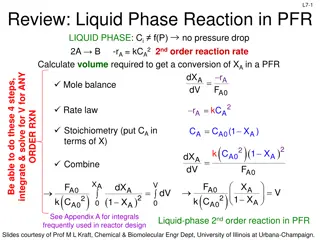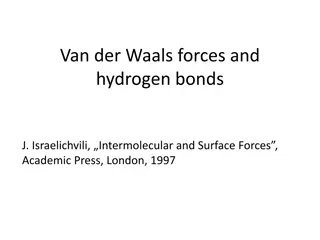Chemistry 222 Exam II Review: Gas Laws, Reactions, and Intermolecular Forces
Explore questions related to gas volume changes with pressure, gas density comparisons, stoichiometry in gas reactions, gas velocity comparisons, pressure comparison between gases, boiling point predictions based on intermolecular forces, and ranking molecules based on intermolecular forces.
Download Presentation

Please find below an Image/Link to download the presentation.
The content on the website is provided AS IS for your information and personal use only. It may not be sold, licensed, or shared on other websites without obtaining consent from the author.If you encounter any issues during the download, it is possible that the publisher has removed the file from their server.
You are allowed to download the files provided on this website for personal or commercial use, subject to the condition that they are used lawfully. All files are the property of their respective owners.
The content on the website is provided AS IS for your information and personal use only. It may not be sold, licensed, or shared on other websites without obtaining consent from the author.
E N D
Presentation Transcript
Chemistry 222 Exam II Review Chapters 9, 10 and 11 Chemistry 222 Professor Michael Russell Last update: 4/29/24 MAR MAR
A sample of gas has a volume of 222 mL at 695 mm Hg and 0 C. What would be the volume of this same sample of gas if it were measured at 333 mm Hg and 0 C? A.894 mL B.463 mL C.657 mL D.359 mL E.-155 mL MAR MAR
Gas density: Which has the greatest density at 25 C and 1.00 atm pressure? A.O2 B.N2 C.H2 D.CO2 E.Xe 32 g/mol 28 g/mol 2 g/mol 44 g/mol 131 g/mol MAR MAR
Diborane reacts with O2to give boric oxide and water vapor: B2H6(g) + 3 O2(g) B2O3(s) + 3 H2O(g) If 1.5 L of B2H6is mixed with O2, what volume of O2is required for reaction? Assume constant T and P. A.1.5 L B.4.5 L C.0.50 L D.6.0 L E.0.0 L MAR MAR
Diborane, B2H6, burns in air according to the equation: B2H6(g) + 3 O2(g) B2O3(s) + 3 H2O(g) There are three gases involved in the reaction above. Place them in order of increasing velocity. A.B2H6< O2< H2O B.O2< B2H6< H2O C.H2O < B2H6< O2 D.O2< H2O < B2H6 MAR MAR
Equal masses of helium and neon are placed in separate containers of equal V at the same T. Compare the pressures of the gases. A.P(He) > P(Ne) B.P(Ne) > P(He) C.P(He) = P(Ne) D.Too much pressure! MAR MAR
Using intermolecular forces, the predicted order of decreasing boiling points for the following substances is A.CH3OH > CH4> H2 B.CH3OH > H2> CH4 C.CH4> CH3OH > H2 D.CH4> H2> CH3OH E.H2> CH4> CH3OH MAR MAR
Rank the following molecules in order of increasing intermolecular forces: SO2, NaCl, CH3OH, He A.NaCl < He < SO2 < CH3OH B.He < CH3OH < SO2 < NaCl C.He < SO2 < CH3OH < NaCl D.He < SO2 < NaCl < CH3OH MAR MAR
When KCl dissolves in water, what types of intermolecular bonds are formed? A.ion-ion B.ion-dipole C.hydrogen bonds D.ion-ion forces and H-bonds E.matrimony bonds MAR MAR
Which of the following should have the highest Hvap? A.F2 B.CH3OH C.H2O D.NH3 E.all have the same Hvap value MAR MAR
The unit cell for a compound of copper and oxygen is illustrated here. All the grey copper atoms are within the unit cell. Determine the formula of the compound. A.CuO B.Cu2O C.CuO2 D.Cu2O3 E.Cu4O9 MAR MAR
Below is a phase diagram for O2. What is the name of the point at P = 2 mm Hg and T = 54.34 K? A. normal freezing point B. triple point C. normal boiling point D. critical point E. freak out point MAR MAR
At right is a phase diagram for O2. Which statement is correct regarding the densities of solid and liquid O2at the same temperature? A.The density of liquid O2is 1.426 g/cm3whereas the density of solid O2is 1.149 g/cm3. B.The density of solid O2is 1.426 g/cm3whereas the density of liquid O2is 1.149 g/cm3. C.The densities of solid and liquid O2are the same. MAR MAR
Below is a phase diagram for O2. In what phase is oxygen found at a pressure of 1 mmHg and a temperature of 55 K? A. solid B. liquid C. vapor D. plasma MAR MAR
Calculate the energy required to convert 1.00 L of liquid ethanol at 25.0 C to a gas at 78.3 C. Constants for ethanol: density = 0.7849 g/mL molar mass = 46.08 g/mol boiling point = 78.3 C heat capacity = 2.44 J/g K heat of vaporization = 38.56 kJ/mol A. -329 kJ B. 329 kJ C. -759 kJ D. 759 kJ E. 0 KJ MAR MAR
You dissolve 92.0 grams of CH3CH2OH, ethanol, in 270 g of water. What is the mole fraction of ethanol in the solution? A.2.0 B.0.12 C.0.067 D.0.0083 E.0 MAR MAR
You dissolve 92.0 grams of CH3CH2OH, ethanol, in 270. g of water. What is the weight percent of ethanol in the solution? A.34.1 % B.17.0 % C.25.4 % D.74.8 % E.100. % MAR MAR
You dissolve 92.0 grams of CH3CH2OH, ethanol, in 270. g of water. What is the molality of ethanol in the solution? A.341 m B.170. m C.0.341 m D.7.41 m E.18.0 m MAR MAR
You dissolve 92.0 grams of CH3CH2OH, ethanol, in 270. g of water, and the density of the solution is 0.9780 g/mL. What is the molarity of ethanol in the solution? A.0.370 M B.2.00 M C.7.42 M D.3.05 M E.5.41 M MAR MAR
An aqueous solution of ethanol (CH3CH2OH) has a solution density of 0.9163 g/mL and a concentration of 0.801 M. What is the mole fraction of ethanol in the solution? A.0.911 B.1.1111 C.0.9839 D.0.0161 E. 4.03 MAR MAR
The Henry's Law constant for N2 in water at 53 C is 8.4 x 10-7M/mm Hg, and the vapor pressure of water at 53 C is 107 torr. Find the equilibrium concentration of N2 in water if the total pressure equals 1 atm. A.5.5 x 10-4M B.9.0 x 10-5M C.6.4 x 10-4M D.3.2 x 10-5M E.42 M MAR MAR
0.0400 mol of I2(10.1 g) is dissolved in 1.96 mol of CCl4(300 g) at 65 C. Given that the vapor pressure of pure CCl4is 504 mm Hg at this temperature, what is the vapor pressure of the CCl4over this solution? A.504 mm Hg B.514 mm Hg C.494 mm Hg D.10.1 mm Hg E.Too much pressure! MAR MAR
What mass of ethylene glycol (HOC2H4OH, molar mass = 62.0 g/mol) must be added to 125 g of water to raise the boiling point by 1.00 C? (kbp(H2O) = +0.512 C/m) A.1.95 g B.0.244 g C.15.1 g D.31.0 g E.0 g MAR MAR
Which water-based solution is expected to have the higher boiling point? A.0.10 molal NaCl B.0.15 molal sugar C.both the same D.not enough information MAR MAR
29.3 g of NaCl (molar mass = 58.5 g/mol) is dissolved in 500. grams water. What is the boiling point of this solution? (kbp(H2O) = +0.512 C/m) A.100.512 C B.98.976 C C.101.02 C D.1.024 C E.104 K MAR MAR
Erythritol occurs naturally in algae and fungi. A solution of 2.50 g of erythritol in 50.0 g of water freezes at -0.762 C. What is the molar mass of the compound? (kfp(H2O) = -1.86 C/m) A. 26.9 g/mol B. 35.5 g/mol C. 122 g/mol D. 224 g/mol E. 0.0100 g/mol MAR MAR
Insulin (20.0 mg) dissolved in 5.00 mL of water at 300. K provides an osmotic pressure of 12.5 mm Hg. What is the molar mass of insulin? A. 18.0 g/mol B. 42.0 g/mol C. 3980 g/mol D. 6010 g/mol E. 12,100 g/mol MAR MAR
End of Review - good luck with your studying! Need more practice? Practice Problem Sets (online) Concept Guides (Companion and online) Chapter Guides (online) End of Chapter Problems in Textbook (every other question has answer at end) Good luck with your studying! MAR MAR























